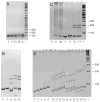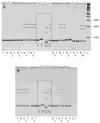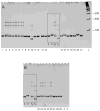Analysis of the AHR gene proximal promoter GGGGC-repeat polymorphism in lung, breast, and colon cancer
- PMID: 25447411
- PMCID: PMC4404625
- DOI: 10.1016/j.taap.2014.10.017
Analysis of the AHR gene proximal promoter GGGGC-repeat polymorphism in lung, breast, and colon cancer
Abstract
The aryl hydrocarbon receptor (AhR) regulates expression of numerous genes, including those of the CYP1 gene family. With the goal of determining factors that control AHR gene expression, our studies are focused on the role of the short tandem repeat polymorphism, (GGGGC)n, located in the proximal promoter of the human AHR gene. When luciferase constructs containing varying GGGGC repeats were transfected into cancer cell lines derived from the lung, colon, and breast, the number of GGGGC repeats affected AHR promoter activity. The number of GGGGC repeats was determined in DNA from 327 humans and from 38 samples representing 5 species of non-human primates. In chimpanzees and 3 species of macaques, only (GGGGC)2 alleles were observed; however, in western gorilla, (GGGGC)n alleles with n=2, 4, 5, 6, 7, and 8 were identified. In all human populations examined, the frequency of (GGGGC)n was n=4>5≫2, 6. When frequencies of the (GGGGC)n alleles in DNA from patients with lung, colon, or breast cancer were evaluated, the occurrence of (GGGGC)2 was found to be 8-fold more frequent among lung cancer patients in comparison with its incidence in the general population, as represented by New York State neonates. Analysis of matched tumor and non-tumor DNA samples from the same individuals provided no evidence of microsatellite instability. These studies indicate that the (GGGGC)n short tandem repeats are inherited, and that the (GGGGC)2 allele in the AHR proximal promoter region should be further investigated with regard to its potential association with lung cancer susceptibility.
Keywords: (GGGGC)(n) repeat polymorphism; Aryl hydrocarbon receptor; Breast cancer; Colon cancer; Lung cancer; Short tandem repeat.
Copyright © 2014 Elsevier Inc. All rights reserved.
Conflict of interest statement
Figures






References
-
- Abel J, Haarmann-Stemmann T. An introduction to the molecular basics of aryl hydrocarbon receptor biology. Biol Chem. 2010;391:1235–1248. - PubMed
-
- Barros P, Blanco MG, Boan F, Gomez-Marquez J. Heteroduplex analysis of minisatellite variability. Electrophoresis. 2005;26:4304–4309. - PubMed
-
- Bernier F, Soucy P, Luu-The V. Human phenol sulfotransferase gene contains two alternative promoters: Structure and expression of the gene. DNA Cell Biol. 1996;15:367–375. - PubMed
-
- Boffetta P, Jourenkova N, Gustavsson P. Cancer risk from occupational and environmental exposure to polycyclic aromatic hydrocarbons. Cancer Causes Control. 1997;8:444–472. - PubMed
Publication types
MeSH terms
Substances
Grants and funding
LinkOut - more resources
Full Text Sources
Other Literature Sources
Medical

